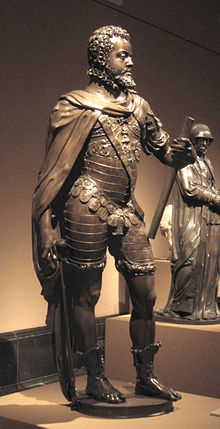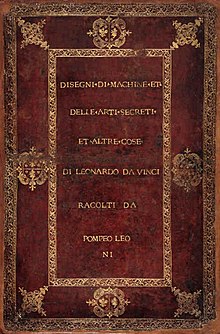Pompeo Leoni

Pompeo Leoni (* around 1530 or 1533 ; † October 9, 1608 in Madrid ) was an Italian sculptor , medalist and art collector .
life and work
Pompeo Leoni was born around 1530 as the son of the sculptor, medalist and goldsmith Leone Leoni (1509–1590), court sculptor of Emperor Charles V (1500–1558). Pompeo learned the art of the sculptor and medalist from his father, who had a workshop in Milan. The building, the so-called "House of Omenoni" (Italian: " Casa degli Omenoni ") in Via degli Omenoni still exists today.
Around 1556 Pompeo followed his father to the Spanish court in Madrid and then spent most of his life in Spain. Although he was sentenced to one year imprisonment by a tribunal of the Inquisition for " Lutheran " speeches in 1558 , he was then appointed court sculptor Philip II (1527–1598) and from 1563 was listed as a citizen of Madrid. Together with his father, Leoni worked on the interior design of the El Escorial palace and created a large part of his life's work in Madrid. So the statues of Charles V and Philip II in the Basilica of the Escorial and the grave sculpture of the Infanta Johanna in the monastery of Descalzas Reales in Madrid . Between 1576 and 1578 he was probably portrayed by El Greco , a painting attributed to the Greek and said to show Leoni was auctioned off to a private collector at Rosenberg & Striebel in New York.
The manuscripts of Leonardo da Vinci
Around 1590 Pompeo Leoni was able to acquire a large part of Leonardo da Vinci's manuscripts , including over 2500 individual sheets. He tried to organize the writings thematically, cut up individual sheets and glued together others that did not originally belong together. He summarized up to six drawings on one page. A work created in this way, later called Codex Atlanticus , in the form created by Leoni, had a circumference of 481 sheets in the format 43.5 cm × 64.5 cm and approx. 60 cm thick. Today the work, which has since been restored and rearranged, is in the holdings of the Biblioteca Ambrosiana in Milan.
Leoni summarized Leonardo da Vinci's anatomical drawings in several volumes, which were later named Codex Windsor together with other thematically differently oriented manuscripts . Since the end of the 17th century, the now individually cataloged, anatomical drawings by da Vinci have been in the collection of the Royal Collection in Windsor Castle .
literature
- Walter Cupperi: Leoni, Pompeo. In: Mario Caravale (ed.): Dizionario Biografico degli Italiani (DBI). Volume 64: Latilla – Levi Montalcini. Istituto della Enciclopedia Italiana, Rome 2005.
- Friedrich Edelmayer : Philipp II., Biography of a world ruler . Kohlhammer Verlag, Stuttgart 2009, ISBN 978-3-17-018067-3 .
- Belén Bartolomé Francia (coordinación): Los Leoni (1509-1608) - Escultores del Renacimento italiano al servicio de la corte de España (catálogo) . Museo del Prado, Madrid 1994, ISBN 84-87317-28-6 .
- Markus Schmidt: Escorial and Valle de los Caidos, consideration of two Spanish buildings . Grin Verlag, Munich 2009, ISBN 978-3-640-25913-7 .
- Charles Nicholl : Leonardo da Vinci - The biography . S. Fischer, Frankfurt am Main 2006, ISBN 3-10-052405-5 .
- Carlo Pedretti : Leonardo da Vinci on Painting . University of California Press, Berkeley / Los Angeles 1964 ( digitized ).
Web links
- The Codex Atlanticus on the website of the Biblioteca Ambrosiana , accessed on March 6, 2011
- Leonardo da Vinci's anatomical drawings on the Royal Collection website , accessed October 5, 2012
- Pompeo Leoni in VD 17
Remarks
- ↑ The place of birth in Milan is not documented in the sources.
Individual evidence
- ^ A b Markus Schmidt: Escorial and Valle de los Caidos, consideration of two Spanish buildings. Grin Verlag, Munich 2009, p. 8.
- ↑ GND 119328887 names 1533–1608 as life data, accessed on August 22, 2020.
- ↑ Leoni, Pompeo. In: L. Forrer: Biographical Dictionary of Medallists. Volume III, London 1907, p. 412 ff.
- ^ Carlo Pedretti: Leonardo da Vinci on Painting. University of California Press, Berkeley / Los Angeles 1964, p. 257.
- ↑ Charles Nicholl: Leonardo da Vinci - The biography. S. Fischer, Frankfurt am Main 2006, p. 21.
- ↑ Markus Bernauer (Ed.): Wilhelm Heinse, The records . Volume 3, Carl Hanser, Munich 2005, ISBN 3-446-20399-0 , p. 1621.
- ^ Henry Schuman (Ed.) Leonardo on the human body . Courier Dover Publications, Mineola N.Y. 1983, ISBN 0-486-24483-0 , p. 34.
| personal data | |
|---|---|
| SURNAME | Leoni, Pompeo |
| ALTERNATIVE NAMES | Lioni, Pompeo |
| BRIEF DESCRIPTION | Italian sculptor and art collector |
| DATE OF BIRTH | 16th Century |
| DATE OF DEATH | October 9, 1608 |
| Place of death | Madrid |

